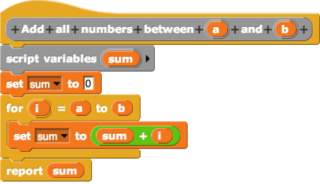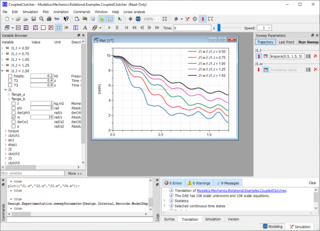
Scilab is a free and open-source, cross-platform numerical computational package and a high-level, numerically oriented programming language. It can be used for signal processing, statistical analysis, image enhancement, fluid dynamics simulations, numerical optimization, and modeling, simulation of explicit and implicit dynamical systems and symbolic manipulations.

In computing, a visual programming language is any programming language that lets users create programs by manipulating program elements graphically rather than by specifying them textually. A VPL allows programming with visual expressions, spatial arrangements of text and graphic symbols, used either as elements of syntax or secondary notation. For example, many VPLs are based on the idea of "boxes and arrows", where boxes or other screen objects are treated as entities, connected by arrows, lines or arcs which represent relations.

Simulink is a MATLAB-based graphical programming environment for modeling, simulating and analyzing multidomain dynamical systems. Its primary interface is a graphical block diagramming tool and a customizable set of block libraries. It offers tight integration with the rest of the MATLAB environment and can either drive MATLAB or be scripted from it. Simulink is widely used in automatic control and digital signal processing for multidomain simulation and model-based design.

Modelica is an object-oriented, declarative, multi-domain modeling language for component-oriented modeling of complex systems, e.g., systems containing mechanical, electrical, electronic, hydraulic, thermal, control, electric power or process-oriented subcomponents. The free Modelica language is developed by the non-profit Modelica Association. The Modelica Association also develops the free Modelica Standard Library that contains about 1400 generic model components and 1200 functions in various domains, as of version 4.0.0.
VisSim is a visual block diagram program for simulation of dynamical systems and model-based design of embedded systems, with its own visual language. It is developed by Visual Solutions of Westford, Massachusetts. Visual Solutions was acquired by Altair in August 2014 and its products have been rebranded as Altair Embed as a part of Altair's Model Based Development Suite. With Embed, you can develop virtual prototypes of dynamic systems. Models are built by sliding blocks into the work area and wiring them together with the mouse. Embed automatically converts the control diagrams into C-code ready to be downloaded to the target hardware.
A discrete-event simulation (DES) models the operation of a system as a (discrete) sequence of events in time. Each event occurs at a particular instant in time and marks a change of state in the system. Between consecutive events, no change in the system is assumed to occur; thus the simulation time can directly jump to the occurrence time of the next event, which is called next-event time progression.
Dynamic simulation is the use of a computer program to model the time-varying behavior of a dynamical system. The systems are typically described by ordinary differential equations or partial differential equations. A simulation run solves the state-equation system to find the behavior of the state variables over a specified period of time. The equation is solved through numerical integration methods to produce the transient behavior of the state variables. Simulation of dynamic systems predicts the values of model-system state variables, as they are determined by the past state values. This relationship is found by creating a model of the system.
Model-based design (MBD) is a mathematical and visual method of addressing problems associated with designing complex control, signal processing and communication systems. It is used in many motion control, industrial equipment, aerospace, and automotive applications. Model-based design is a methodology applied in designing embedded software.

Dymola is a commercial modeling and simulation environment based on the open Modelica modeling language.

MapleSim is a Modelica-based, multi-domain modeling and simulation tool developed by Maplesoft. MapleSim generates model equations, runs simulations, and performs analyses using the symbolic and numeric mathematical engine of Maple. Models are created by dragging-and-dropping components from a library into a central workspace, resulting in a model that represents the physical system in a graphical form. Maplesoft began development of MapleSim partly in response to a request from Toyota to produce physical modeling tools to aid in their new model-based development process.

SimulationX is a CAE software application running on Microsoft Windows for the physical simulation of technical systems. It is developed and sold by ESI Group.

ScicosLab is a software package providing a multi-platform environment for scientific computation. It is based on the official Scilab 4.x (BUILD4) distribution, and includes the modeling and simulation tool Scicos and a number of other toolboxes.
MLDesigner is an integrated modeling and simulation tool for the design and analysis of complex embedded and networked systems. MLDesigner speeds up modeling, simulation and analysis of discrete event, discrete time and continuous time systems concerning architecture, function and performance. The tools is based on ideas of the "Ptolemy Project", done at the University if California Berkeley. MLDesigner is developed by MLDesign Technologies Inc. Palo Alto, CA, USA in collaboration with Mission Level Design GmbH, Ilmenau, Germany.
The Functional Mock-up Interface defines a standardized interface to be used in computer simulations to develop complex cyber-physical systems.
JModelica.org is a commercial software platform based on the Modelica modeling language for modeling, simulating, optimizing and analyzing complex dynamic systems. The platform is maintained and developed by Modelon AB in collaboration with academic and industrial institutions, notably Lund University and the Lund Center for Control of Complex Systems (LCCC). The platform has been used in industrial projects with applications in robotics, vehicle systems, energy systems, CO2 separation and polyethylene production.
Simcenter Amesim is a commercial simulation software for the modeling and analysis of multi-domain systems. It is part of systems engineering domain and falls into the mechatronic engineering field.
System-level simulation (SLS) is a collection of practical methods used in the field of systems engineering, in order to simulate, with a computer, the global behavior of large cyber-physical systems.
OpenModelica is a free and open source environment based on the Modelica modeling language for modeling, simulating, optimizing and analyzing complex dynamic systems. This software is actively developed by Open Source Modelica Consortium, a non-profit, non-governmental organization. The Open Source Modelica Consortium is run as a project of RISE SICS East AB in collaboration with Linköping University.







